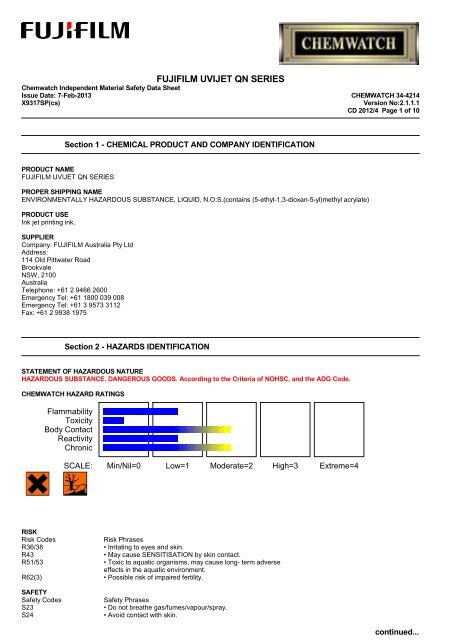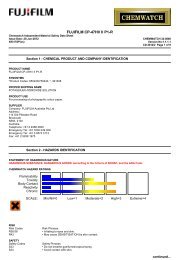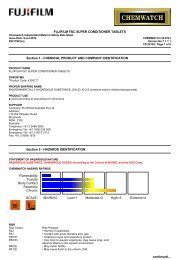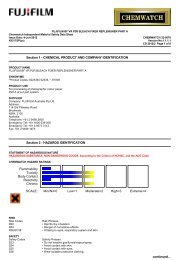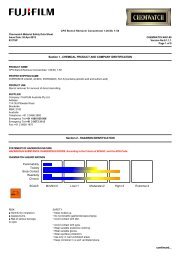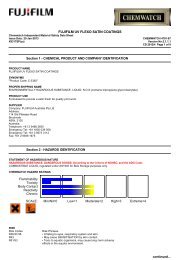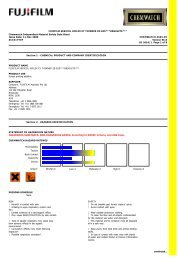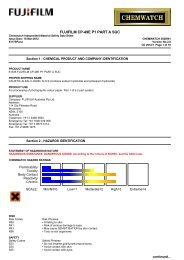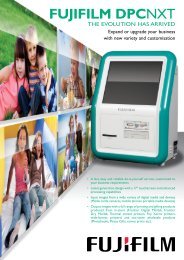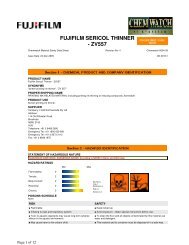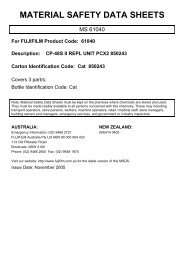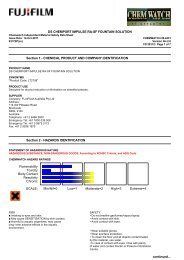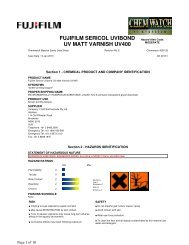Chemwatch Australian MSDS 34-4214 - FUJIFILM Australia
Chemwatch Australian MSDS 34-4214 - FUJIFILM Australia
Chemwatch Australian MSDS 34-4214 - FUJIFILM Australia
You also want an ePaper? Increase the reach of your titles
YUMPU automatically turns print PDFs into web optimized ePapers that Google loves.
<strong>FUJIFILM</strong> UVIJET QN SERIES<strong>Chemwatch</strong> Independent Material Safety Data SheetIssue Date: 7-Feb-2013 CHEMWATCH <strong>34</strong>-<strong>4214</strong>X9317SP(cs)Version No:2.1.1.1CD 2012/4 Page 1 of 10Section 1 - CHEMICAL PRODUCT AND COMPANY IDENTIFICATIONPRODUCT NAME<strong>FUJIFILM</strong> UVIJET QN SERIESPROPER SHIPPING NAMEENVIRONMENTALLY HAZARDOUS SUBSTANCE, LIQUID, N.O.S.(contains (5-ethyl-1,3-dioxan-5-yl)methyl acrylate)PRODUCT USEInk jet printing ink.SUPPLIERCompany: <strong>FUJIFILM</strong> <strong>Australia</strong> Pty LtdAddress:114 Old Pittwater RoadBrookvaleNSW, 2100<strong>Australia</strong>Telephone: +61 2 9466 2600Emergency Tel: +61 1800 039 008Emergency Tel: +61 3 9573 3112Fax: +61 2 9938 1975Section 2 - HAZARDS IDENTIFICATIONSTATEMENT OF HAZARDOUS NATUREHAZARDOUS SUBSTANCE. DANGEROUS GOODS. According to the Criteria of NOHSC, and the ADG Code.CHEMWATCH HAZARD RATINGSFlammabilityToxicityBody ContactReactivityChronicSCALE: Min/Nil=0 Low=1 Moderate=2 High=3 Extreme=4RISKRisk CodesRisk PhrasesR36/38 • Irritating to eyes and skin.R43• May cause SENSITISATION by skin contact.R51/53 • Toxic to aquatic organisms, may cause long- term adverseeffects in the aquatic environment.R62(3)• Possible risk of impaired fertility.SAFETYSafety CodesS23S24Safety Phrases• Do not breathe gas/fumes/vapour/spray.• Avoid contact with skin.continued...
<strong>FUJIFILM</strong> UVIJET QN SERIES<strong>Chemwatch</strong> Independent Material Safety Data SheetIssue Date: 7-Feb-2013 CHEMWATCH <strong>34</strong>-<strong>4214</strong>X9317SP(cs)Version No:2.1.1.1CD 2012/4 Page 3 of 10Section 5 - FIRE FIGHTING MEASURESEXTINGUISHING MEDIA• Foam.• Dry chemical powder.• BCF (where regulations permit).• Carbon dioxide.FIRE FIGHTING• Alert Fire Brigade and tell them location and nature of hazard.• May be violently or explosively reactive.• Wear full body protective clothing with breathing apparatus.• Prevent, by any means available, spillage from entering drains or water course.FIRE/EXPLOSION HAZARD• Combustible.• Slight fire hazard when exposed to heat or flame.• Heating may cause expansion or decomposition leading to violent rupture of containers.• On combustion, may emit toxic fumes of carbon monoxide (CO).Combustion products include: carbon dioxide (CO2), nitrogen oxides (NOx), other pyrolysis products typical of burning organicmaterial.FIRE INCOMPATIBILITY• Avoid contamination with oxidising agents i.e. nitrates, oxidising acids, chlorine bleaches, pool chlorine etc. as ignition mayresult.HAZCHEM•3ZSection 6 - ACCIDENTAL RELEASE MEASURESMINOR SPILLS■ Environmental hazard - contain spillage.• Clean up all spills immediately.• Avoid breathing vapours and contact with skin and eyes.• Control personal contact with the substance, by using protective equipment.• Contain and absorb spill with sand, earth, inert material or vermiculite.MAJOR SPILLS■ Environmental hazard - contain spillage.Moderate hazard.• Clear area of personnel and move upwind.• Alert Fire Brigade and tell them location and nature of hazard.• Wear breathing apparatus plus protective gloves.• Prevent, by any means available, spillage from entering drains or water course.Personal Protective Equipment advice is contained in Section 8 of the <strong>MSDS</strong>.Section 7 - HANDLING AND STORAGEPROCEDURE FOR HANDLING• Most acrylic monomers have low viscosity therefore pouring, material transfer and processing of these materials do notnecessitate heating.• Viscous monomers may require heating to facilitate handling. To facilitate product transfer from original containers, productmust be heated to no more than 60 deg. C. (140 F.), for not more than 24 hours.• Do NOT use localised heat sources such as band heaters to heat/ melt product.• Do NOT use steam .• DO NOT allow clothing wet with material to stay in contact with skin.• Avoid all personal contact, including inhalation.• Wear protective clothing when risk of exposure occurs.• Use in a well-ventilated area.• Prevent concentration in hollows and sumps.continued...
<strong>FUJIFILM</strong> UVIJET QN SERIES<strong>Chemwatch</strong> Independent Material Safety Data SheetIssue Date: 7-Feb-2013 CHEMWATCH <strong>34</strong>-<strong>4214</strong>X9317SP(cs)Version No:2.1.1.1CD 2012/4 Page 4 of 10Section 7 - HANDLING AND STORAGESUITABLE CONTAINER• Metal can or drum• Packaging as recommended by manufacturer.• Check all containers are clearly labelled and free from leaks.STORAGE INCOMPATIBILITY■ for multifunctional acrylates:• Avoid exposure to free radical initiators (peroxides, persulfates) , iron, rust, oxidisers, and strong acids and strong bases.• Avoid heat, flame, sunlight, X-rays or ultra-violet radiation.• Storage beyond expiration date, may initiate polymerisation. Polymerisation of large quantities may be violent (even explosive).STORAGE REQUIREMENTS• Polymerisation may occur slowly at room temperature.• Storage requires stabilising inhibitor content and dissolved oxygen content to be monitored. Refer to manufacturer'srecommended levels.• DO NOT overfill containers so as to maintain free head space above product.• Blanketing or sparging with nitrogen or oxygen free gas will deactivate stabiliser.• Store below 38 deg. C.• Store in original containers.• Keep containers securely sealed.• Store in a cool, dry, well-ventilated area.• Store away from incompatible materials and foodstuff containers.Section 8 - EXPOSURE CONTROLS / PERSONAL PROTECTIONEXPOSURE CONTROLSThe following materials had no OELs on our records• (5- ethyl- 1, 3- dioxan- 5- yl)methyl acrylate: CAS:66492- 51- 1 CAS:181719- 68- 6• N- vinylcaprolactam: CAS:2235- 00- 9• diphenyl(2, 4, 6- trimethylbenzoyl)phosphine: CAS:75980- 60- 8 CAS:596818- 40- 5• hexanediol diacrylate: CAS:13048- 33- 4• iso- decyl acrylate: CAS:1330- 61- 6• trimethylolpropane triacrylate: CAS:15625- 89- 5• glycerol propoxylate triacrylate: CAS:52408- 84- 1MATERIAL DATA(5-ETHYL-1,3-DIOXAN-5-YL)METHYL ACRYLATE:GLYCEROL PROPOXYLATE TRIACRYLATE:HEXANEDIOL DIACRYLATE:N-VINYLCAPROLACTAM:■ Sensory irritants are chemicals that produce temporary and undesirable side-effects on the eyes, nose or throat.Historically occupational exposure standards for these irritants have been based on observation of workers' responses to variousairborne concentrations.<strong>FUJIFILM</strong> UVIJET QN SERIES:GLYCEROL PROPOXYLATE TRIACRYLATE:HEXANEDIOL DIACRYLATE:TRIMETHYLOLPROPANE TRIACRYLATE:■ CEL TWA: 1 mg/m3 [compare WEEL-TWA* for multifunctional acrylates (MFAs)](CEL = <strong>Chemwatch</strong> Exposure Limit)Exposure to MFAs has been reported to cause contact dermatitis in humans and serious eye injury in laboratory animals.Exposure to some MFA-resin containing aerosols has also been reported to cause dermatitis.DIPHENYL(2,4,6-TRIMETHYLBENZOYL)PHOSPHINE:N-VINYLCAPROLACTAM:■ It is the goal of the ACGIH (and other Agencies) to recommend TLVs (or their equivalent) for all substances for which thereis evidence of health effects at airborne concentrations encountered in the workplace.At this time no TLV has been established, even though this material may produce adverse health effects (as evidenced in animalexperiments or clinical experience).NOTE: The ACGIH occupational exposure standard for Particles Not Otherwise Specified (P.N.O.S) does NOT apply.ISO-DECYL ACRYLATE:■ The recommended TLV-TWA for hydroquinone takes into account the toxicology of hydroquinone and experience of industrialexposures to benzenediols. Exposure at or below the limit is thought to minimise the risk to workers of eye injury, dermatitisand central nervous system effects.CEL TWA 5 ppm, 43 mg/m3TRIMETHYLOLPROPANE TRIACRYLATE:continued...
<strong>FUJIFILM</strong> UVIJET QN SERIES<strong>Chemwatch</strong> Independent Material Safety Data SheetIssue Date: 7-Feb-2013 CHEMWATCH <strong>34</strong>-<strong>4214</strong>X9317SP(cs)Version No:2.1.1.1CD 2012/4 Page 5 of 10Section 8 - EXPOSURE CONTROLS / PERSONAL PROTECTION■ For 4-methoxyphenol (MEHQ)MEHQ has caused ocular toxicity in animals and skin depigmentation in rodents and workers. The recommendation for the TLV-TWAarises from documented eye and skin toxicities and by analogy with hydroquinone.PERSONAL PROTECTIONRESPIRATOR•Type A-P Filter of sufficient capacity. (AS/NZS 1716 & 1715, EN 143:2000 & 149:2001, ANSI Z88 or national equivalent)EYE• Safety glasses with side shields.• Chemical goggles.• Contact lenses may pose a special hazard; soft contact lenses may absorb and concentrate irritants. A written policy document,describing the wearing of lens or restrictions on use, should be created for each workplace or task. This should include areview of lens absorption and adsorption for the class of chemicals in use and an account of injury experience. Medical andfirst-aid personnel should be trained in their removal and suitable equipment should be readily available. In the event ofchemical exposure, begin eye irrigation immediately and remove contact lens as soon as practicable. Lens should be removed atthe first signs of eye redness or irritation - lens should be removed in a clean environment only after workers have washedhands thoroughly. [CDC NIOSH Current Intelligence Bulletin 59], [AS/NZS 1336 or national equivalent].HANDS/FEET■ NOTE:• The material may produce skin sensitisation in predisposed individuals. Care must be taken, when removing gloves and otherprotective equipment, to avoid all possible skin contact.• Contaminated leather items, such as shoes, belts and watch-bands should be removed and destroyed.The selection of the suitable gloves does not only depend on the material, but also on further marks of quality which vary frommanufacturer to manufacturer. Where the chemical is a preparation of several substances, the resistance of the glove material cannot be calculated in advance and has therefore to be checked prior to the application.The exact break through time for substances has to be obtained from the manufacturer of the protective gloves andhas to be observed when making a final choice.Suitability and durability of glove type is dependent on usage. Important factors in the selection of gloves include:.General warning: Do NOT use latex gloves! Use only recommended gloves - using the wrong gloves may increase the risk:Exposure condition Short time use; (few minutesless than 0.5 hour) Little physical stressExposure condition Medium time use; less than 4hours Physical stress (opening drums, usingtools, etc.)Exposure condition Long time CleaningoperationsUse of thin nitrile rubber gloves: Nitrilerubber (0.1 mm) Excellent tactibility (" feel"), powder- free Disposable Inexpensive Giveadequate protection to low molecular weighacrylic monomersUse of medium thick nitrile rubber glovesNitrile rubber, NRL (latex) free; 0.56 mm lowtactibility (" feel" ), powder free High priceGives adequate protection for most acrylates incombination with commonly used solvents up to 8hours Do NOT give adequate protection to lowmolecular weight monomers at exposures longerthan 1 hour Avoid use of ketones and acetatesin wash- up solutions..OTHER• Overalls.• P.V.C. apron.• Barrier cream.• Skin cleansing cream.ENGINEERING CONTROLS■ Engineering controls are used to remove a hazard or place a barrier between the worker and the hazard. Well-designedengineering controls can be highly effective in protecting workers and will typically be independent of worker interactions toprovide this high level of protection.continued...
<strong>FUJIFILM</strong> UVIJET QN SERIES<strong>Chemwatch</strong> Independent Material Safety Data SheetIssue Date: 7-Feb-2013 CHEMWATCH <strong>34</strong>-<strong>4214</strong>X9317SP(cs)Version No:2.1.1.1CD 2012/4 Page 7 of 10Section 11 - TOXICOLOGICAL INFORMATIONirritation can cause further lung damage.CHRONIC HEALTH EFFECTS■ Skin contact with the material is more likely to cause a sensitisation reaction in some persons compared to the generalpopulation.Ample evidence from experiments exists that there is a suspicionthis material directly reduces fertility.Substance accumulation, in the human body, may occur and may cause some concern following repeated or long-term occupationalexposure.There is some evidence that inhaling this product is more likely to cause a sensitisation reaction in some persons compared tothe general population.Sensitisation may give severe responses to very low levels of exposure, i.e. hypersensitivity. Sensitised persons should not beallowed to work in situations where exposure may occur.TOXICITY AND IRRITATION■ Contact allergies quickly manifest themselves as contact eczema, more rarely as urticaria or Quincke's oedema. The pathogenesisof contact eczema involves a cell-mediated (T lymphocytes) immune reaction of the delayed type. Other allergic skin reactions,e.g. contact urticaria, involve antibody-mediated immune reactions. The significance of the contact allergen is not simplydetermined by its sensitisation potential: the distribution of the substance and the opportunities for contact with it areequally important. A weakly sensitising substance which is widely distributed can be a more important allergen than one withstronger sensitising potential with which few individuals come into contact. From a clinical point of view, substances arenoteworthy if they produce an allergic test reaction in more than 1% of the persons tested.UV (ultraviolet)/ EB (electron beam) acrylates are generally of low toxicityUV/EB acrylates are divided into two groups; "stenomeric" and "eurymeric" acrylates.The first group consists of well-defined acrylates which can be described by a simple idealised chemical;they are low molecularweight species with a very narrow weight distribution profile.The eurymeric acrylates cannot be described by an idealised structure and may differ fundamentally between various suppliers;they are of relatively high molecular weigh and possess a wide weight distribution.Stenomeric acrylates are usually more hazardous than the eurymeric substances.Asthma-like symptoms may continue for months or even years after exposure to the material ceases. This may be due to a nonallergeniccondition known as reactive airways dysfunction syndrome (RADS) which can occur following exposure to high levels ofhighly irritating compound.Where no "official" classification for acrylates and methacrylates exists, there has been cautious attempts to createclassifications in the absence of contrary evidence. For exampleMonalkyl or monoarylesters of acrylic acids should be classified as R36/37/38 and R51/53Monoalkyl or monoaryl esters of methacrylic acid should be classified as R36/37/38.SKINiso- decyl acrylate GESAMP/EHS Composite List - GESAMP Hazard D1: skin 2Profilesirritation/corrosionSection 12 - ECOLOGICAL INFORMATIONToxic to aquatic organisms, may cause long-term adverse effects in the aquatic environment.This material and its container must be disposed of as hazardous waste.Avoid release to the environment.Refer to special instructions/ safety data sheets.EcotoxicityIngredient Persistence: Persistence: Air Bioaccumulation MobilityWater/Soil(5- ethyl- 1, 3- dioxan- 5- No Data No Data No Data No Datayl)methyl acrylate Available Available Available AvailableN- vinylcaprolactam LOW No Data LOW HIGHAvailablediphenyl(2, 4, 6- HIGH No Data LOW LOWtrimethylbenzoyl)phosphineAvailablehexanediol diacrylate No Data No Data No Data No DataAvailable Available Available Availableiso- decyl acrylate LOW No Data LOW MEDAvailabletrimethylolpropane triacrylate LOW No Data LOW MEDAvailableglycerol propoxylate triacrylate No Data No Data No Data No DataAvailable Available Available Availablecontinued...
<strong>FUJIFILM</strong> UVIJET QN SERIES<strong>Chemwatch</strong> Independent Material Safety Data SheetIssue Date: 7-Feb-2013 CHEMWATCH <strong>34</strong>-<strong>4214</strong>X9317SP(cs)Version No:2.1.1.1CD 2012/4 Page 8 of 10Section 13 - DISPOSAL CONSIDERATIONS• Containers may still present a chemical hazard/ danger when empty.• Return to supplier for reuse/ recycling if possible.Otherwise:• If container can not be cleaned sufficiently well to ensure that residuals do not remain or if the container cannot be used tostore the same product, then puncture containers, to prevent re-use, and bury at an authorised landfill.• Where possible retain label warnings and <strong>MSDS</strong> and observe all notices pertaining to the product.Legislation addressing waste disposal requirements may differ by country, state and/ or territory. Each user must refer to lawsoperating in their area.A Hierarchy of Controls seems to be common - the user should investigate:• Reduction.• DO NOT allow wash water from cleaning or process equipment to enter drains.• It may be necessary to collect all wash water for treatment before disposal.• In all cases disposal to sewer may be subject to local laws and regulations and these should be considered first.• Where in doubt contact the responsible authority.• Recycle wherever possible or consult manufacturer for recycling options.• Consult State Land Waste Authority for disposal.• Bury or incinerate residue at an approved site.• Recycle containers if possible, or dispose of in an authorised landfill.Section 14 - TRANSPORTATION INFORMATION■ Environmentally Hazardous Substances meeting the descriptions of UN 3077 or UN 3082are not subject to this Code when transported by road or rail in;(a) packagings;(b) IBCs; or(c) any other receptacle not exceeding 500 kg(L).- <strong><strong>Australia</strong>n</strong> Special Provisions (SP AU01) - ADG Code 7th Ed.Labels Required: MISCELLANEOUSHAZCHEM:•3Z (ADG7)ADG7:Class or Division: 9 Subsidiary Risk: NoneUN No.: 3082 Packing Group: IIISpecial Provision: 179 274 331 335 AU01 Limited Quantity: 5 LPortable Tanks & Bulk T4 Portable Tanks & Bulk TP1 TP29Containers -Containers - SpecialInstruction:Provision:Packagings & IBCs - P001 IBC03 LP01 Packagings & IBCs - PP1Packing Instruction:Special PackingProvision:Name and Description: ENVIRONMENTALLY HAZARDOUS SUBSTANCE, LIQUID,N.O.S. (contains (5-ethyl-1,3-dioxan-5-yl)methyl acrylate)Land Transport UNDG:Class or division: 9 Subsidiary risk: NoneUN No.: 3082 UN packing group: IIIShipping Name:ENVIRONMENTALLY HAZARDOUS SUBSTANCE, LIQUID, N.O.S.(contains (5-ethyl-1,3-dioxan-5-yl)methyl acrylate)Air Transport IATA:ICAO/IATA Class: 9 ICAO/IATA Subrisk: NoneUN/ID Number: 3082 Packing Group: IIISpecial provisions:A97Shipping name:ENVIRONMENTALLY HAZARDOUS SUBSTANCE, LIQUID, N.O.S.(contains (5-ethyl-1,3-dioxan-5-yl)methyl acrylate)Maritime Transport IMDG:IMDG Class: 9 IMDG Subrisk: NoneUN Number: 3082 Packing Group: IIIcontinued...
<strong>FUJIFILM</strong> UVIJET QN SERIES<strong>Chemwatch</strong> Independent Material Safety Data SheetIssue Date: 7-Feb-2013 CHEMWATCH <strong>34</strong>-<strong>4214</strong>X9317SP(cs)Version No:2.1.1.1CD 2012/4 Page 9 of 10Section 14 - TRANSPORTATION INFORMATIONEMS Number: F- A, S- F Special provisions: 274 335Limited Quantities: 5 L Marine Pollutant: YesShipping name:ENVIRONMENTALLY HAZARDOUS SUBSTANCE, LIQUID, N.O.S.(contains (5-ethyl-1,3-dioxan-5-yl)methyl acrylate)Section 15 - REGULATORY INFORMATIONIndications of Danger:NXnDangerous for the environmentHarmfulPOISONS SCHEDULE NoneREGULATIONSRegulations for ingredients(5-ethyl-1,3-dioxan-5-yl)methyl acrylate (CAS: 66492-51-1,181719-68-6) is found on thefollowing regulatory lists;"<strong>Australia</strong> Inventory of Chemical Substances (AICS)"N-vinylcaprolactam (CAS: 2235-00-9) is found on the following regulatory lists;"<strong>Australia</strong> Inventory of Chemical Substances (AICS)","<strong>Australia</strong> National Pollutant Inventory","OECD List of High Production Volume(HPV) Chemicals","Sigma-AldrichTransport Information"diphenyl(2,4,6-trimethylbenzoyl)phosphine (CAS: 75980-60-8,596818-40-5) is found on thefollowing regulatory lists;"<strong>Australia</strong> Inventory of Chemical Substances (AICS)","<strong>Australia</strong> National Pollutant Inventory","Sigma-AldrichTransport Information"hexanediol diacrylate (CAS: 13048-33-4) is found on the following regulatory lists;"<strong>Australia</strong> Hazardous Substances","<strong>Australia</strong> Inventory of Chemical Substances (AICS)","OECD List of High Production Volume (HPV)Chemicals","Sigma-AldrichTransport Information"iso-decyl acrylate (CAS: 1330-61-6) is found on the following regulatory lists;"<strong>Australia</strong> Inventory of Chemical Substances (AICS)","OECD List of High Production Volume (HPV) Chemicals","Sigma-AldrichTransportInformation"trimethylolpropane triacrylate (CAS: 15625-89-5) is found on the following regulatory lists;"<strong>Australia</strong> Hazardous Substances","<strong>Australia</strong> Inventory of Chemical Substances (AICS)","OECD List of High Production Volume (HPV)Chemicals","Sigma-AldrichTransport Information"glycerol propoxylate triacrylate (CAS: 52408-84-1) is found on the following regulatory lists;"<strong>Australia</strong> Inventory of Chemical Substances (AICS)","Sigma-AldrichTransport Information"No data for Fujifilm Uvijet QN Series (CW: <strong>34</strong>-<strong>4214</strong>)Section 16 - OTHER INFORMATIONDenmark Advisory list for selfclassification of dangerous substancesSubstance CAS Suggested codes(5- ethyl- 1, 3- dioxan- 5- yl)methyl 66492- 51- 1 Carc3; R40 Xn;acrylate R22 Xi; R38 N;R51/53N- vinylcaprolactam 2235- 00- 9 Rep3; R63INGREDIENTS WITH MULTIPLE CAS NUMBERSIngredient NameCAS(5- ethyl- 1, 3- dioxan- 5- yl)methyl acrylate 66492- 51- 1, 181719- 68- 6diphenyl(2, 4, 6- trimethylbenzoyl)phosphine 75980- 60- 8, 596818- 40- 5■ Classification of the preparation and its individual components has drawn on official and authoritative sources as well asindependent review by the <strong>Chemwatch</strong> Classification committee using available literature references.A list of reference resources used to assist the committee may be found at:www.chemwatch.net/references.■ The (M)SDS is a Hazard Communication tool and should be used to assist in the Risk Assessment. Many factors determine whetherthe reported Hazards are Risks in the workplace or other settings.continued...


